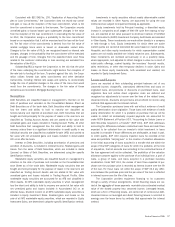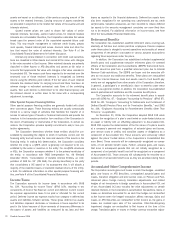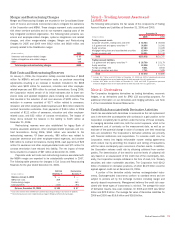Bank of America 2006 Annual Report Download - page 108
Download and view the complete annual report
Please find page 108 of the 2006 Bank of America annual report below. You can navigate through the pages in the report by either clicking on the pages listed below, or by using the keyword search tool below to find specific information within the annual report.determined rate or price during a period or at a time in the future. Option
agreements can be transacted on organized exchanges or directly between
parties. The Corporation also provides credit derivatives to customers who
wish to increase or decrease credit exposures. In addition, the Corporation
utilizes credit derivatives to manage the credit risk associated with the
loan portfolio.
All derivatives are recognized on the Consolidated Balance Sheet at
fair value, taking into consideration the effects of legally enforceable
master netting agreements that allow the Corporation to settle positive
and negative positions and offset cash collateral held with the same coun-
terparty on a net basis. For exchange-traded contracts, fair value is based
on quoted market prices. For non-exchange traded contracts, fair value is
based on dealer quotes, pricing models or quoted prices for instruments
with similar characteristics.
The Corporation recognizes gains and losses at inception of a
derivative contract only if the fair value of the contract is evidenced by a
quoted market price in an active market, an observable price or other
market transaction, or other observable data supporting a valuation model
in accordance with Emerging Issues Task Force (EITF) Issue No. 02-3,
“Issues Involved in Accounting for Derivative Contracts Held for Trading
Purposes and Contracts Involved in Energy Trading and Risk Management
Activities” (EITF 02-3). For those gains and losses not evidenced by the
above mentioned market data, the transaction price is used as the fair
value of the derivative contract. Any difference between the transaction
price and the model fair value is considered an unrecognized gain or loss
at inception of the contract. These unrecognized gains and losses are
recorded in income using the straight line method of amortization over the
contractual life of the derivative contract. Earlier recognition of the full
unrecognized gain or loss is permitted if the trade is terminated early,
subsequent market activity is observed which supports the model fair
value of the contract, or significant inputs used in the valuation model
become observable in the market. As of December 31, 2006, the balance
of the above unrecognized gains and losses was not material. SFAS 157,
when adopted, will nullify certain guidance in EITF 02-3 and, as a result, a
portion of the above unrecognized gains and losses will be accounted for
as a cumulative-effect adjustment to the opening balance of Retained
Earnings.
Trading Derivatives and Economic Hedges
The Corporation designates at inception whether the derivative contract is
considered hedging or non-hedging for SFAS 133 accounting purposes.
Derivatives held for trading purposes are included in Derivative Assets or
Derivative Liabilities with changes in fair value reflected in Trading Account
Profits.
Derivatives used as economic hedges but not designated in a hedg-
ing relationship for accounting purposes are also included in Derivative
Assets or Derivative Liabilities. Changes in the fair value of derivatives that
serve as economic hedges of MSRs are recorded in Mortgage Banking
Income. Changes in the fair value of derivatives that serve as asset and
liability management (ALM) economic hedges, which do not qualify or were
not designated as accounting hedges, are recorded in Other Income.
Credit derivatives used by the Corporation do not qualify for hedge
accounting under SFAS 133 despite being effective economic hedges with
changes in the fair value of these derivatives included in Other Income.
Derivatives Used For SFAS 133 Hedge Accounting Purposes
For SFAS 133 hedges, the Corporation formally documents at inception all
relationships between hedging instruments and hedged items, as well as
its risk management objectives and strategies for undertaking various
accounting hedges. Additionally, the Corporation uses dollar offset or
regression analysis at the hedge’s inception and for each reporting period
thereafter to assess whether the derivative used in its hedging transaction
is expected to be and has been highly effective in offsetting changes in
the fair value or cash flows of the hedged items. The Corporation dis-
continues hedge accounting when it is determined that a derivative is not
expected to be or has ceased to be highly effective as a hedge, and then
reflects changes in fair value in earnings after termination of the hedge
relationship.
The Corporation uses its derivatives designated as hedging for
accounting purposes as either fair value hedges, cash flow hedges or
hedges of net investments in foreign operations. The Corporation manages
interest rate and foreign currency exchange rate sensitivity predominantly
through the use of derivatives. Fair value hedges are used to protect
against changes in the fair value of the Corporation’s assets and liabilities
that are due to interest rate or foreign exchange volatility. Cash flow
hedges are used to minimize the variability in cash flows of assets or
liabilities, or forecasted transactions caused by interest rate or foreign
exchange fluctuation. For cash flow hedges, the maximum length of time
over which forecasted transactions are hedged is 29 years, with a sub-
stantial portion of the hedged transactions being less than 10 years.
Changes in the fair value of derivatives designated as fair value hedges
are recorded in earnings, together with changes in the fair value of the
related hedged item. Changes in the fair value of derivatives designated
as cash flow hedges are recorded in Accumulated OCI and are reclassified
into the line item in the Consolidated Statement of Income in which the
hedged item is recorded in the same period the hedged item affects earn-
ings. Hedge ineffectiveness and gains and losses on the excluded compo-
nent of a derivative in assessing hedge effectiveness are recorded in
earnings in the same income statement caption that is used to record
hedge effectiveness. SFAS 133 retains certain concepts under SFAS
No. 52, “Foreign Currency Translation,” (SFAS 52) for foreign currency
exchange hedging. Consistent with SFAS 52, the Corporation records
changes in the fair value of derivatives used as hedges of the net invest-
ment in foreign operations, to the extent effective, as a component of
Accumulated OCI.
If a derivative instrument in a fair value hedge is terminated or the
hedge designation removed, the previous adjustments to the carrying
amount of the hedged asset or liability are subsequently accounted for in
the same manner as other components of the carrying amount of that
asset or liability. For interest-earning assets and interest-bearing liabilities,
such adjustments are amortized to earnings over the remaining life of the
respective asset or liability. If a derivative instrument in a cash flow hedge
is terminated or the hedge designation is removed, related amounts in
Accumulated OCI are reclassified into earnings in the same period or peri-
ods during which the hedged forecasted transaction affects earnings. If it
is probable that a forecasted transaction will not occur, any related
amounts in Accumulated OCI are reclassified into earnings in that period.
Interest Rate Lock Commitments
The Corporation enters into interest rate lock commitments (IRLCs) in
connection with its mortgage banking activities to fund residential mort-
gage loans at specified times in the future. IRLCs that relate to the origi-
nation of mortgage loans that will be held for sale are considered
derivative instruments under SFAS No. 149, “Amendment of Statement
133 on Derivative Instruments and Hedging Activities.” As such, these
IRLCs are recorded at fair value with changes in fair value recorded in
Mortgage Banking Income.
106
Bank of America 2006
























